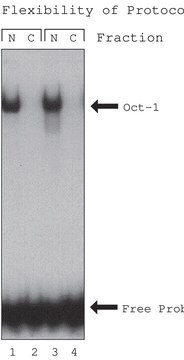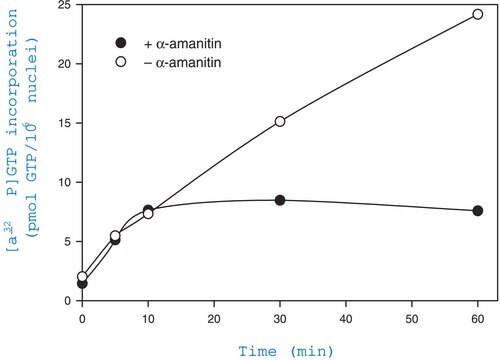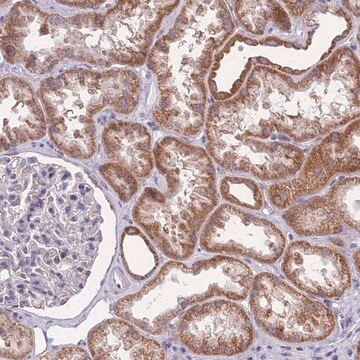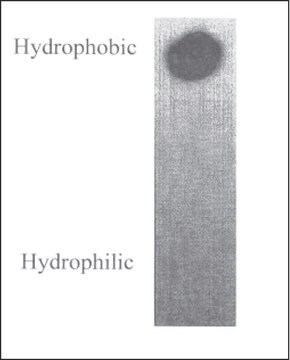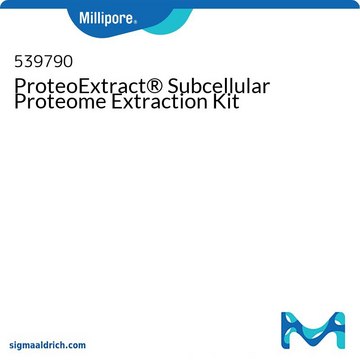CELLYTPN1
CelLytic™ PN Isolation/Extraction Kit
For plant leaves
Sinônimo(s):
Cell lysis kit
Faça loginpara ver os preços organizacionais e de contrato
About This Item
Código UNSPSC:
41116134
NACRES:
NA.56
Produtos recomendados
Nível de qualidade
uso
kit sufficient for 30 extractions (20 g of fresh or frozen leaves)
técnica(s)
ChIP: suitable
Condições de expedição
wet ice
temperatura de armazenamento
2-8°C
Descrição geral
CelLytic™-PN extraction kit is for the isolation of nuclei and extraction of functional nuclear proteins from plant leaves. Nuclei or nuclear proteins can be extracted from few grams to hundreds grams of fresh and frozen leaves. The nuclear protein extract is suitable for the detection of DNA-protein interactions using gel-shift assay, DNase-I footprinting analysis as well as western blot assay and similar techniques. The isolated nuclei can also be used as a source for chromatin, genomic DNA and histones.
Aplicação
The nuclear protein extract is suitable for the detection of DNA-protein interactions using gel-shift assay, DNase-I footprinting analysis as well as Western blot assay and similar techniques. The isolated nuclei can also be used as a source for chromatin, genomic DNA, RNA, etc. The kit provides a detailed protocol for nuclei isolation and protein extraction from four plant models: tobacco, tomato, spinach, and Arabidopsis.
Características e benefícios
Efficient Nuclei Isolation and Protein Extraction: CelLytic™ PN Isolation/Extraction Kit provides a fast and efficient method for isolating nuclei and extracting functional nuclear proteins from plant leaves, saving time and effort for academic researchers.
Versatility: The isolated nuclei can be used as a source for chromatin, genomic DNA, RNA, etc., making CelLytic™ PN Isolation/Extraction Kit a versatile solution for plant molecular biology research.
Suitable for Detection of DNA-Protein Interactions: The nuclear protein extract obtained using this kit is ideal for detecting DNA-protein interactions using gel-shift assay, DNase-I footprinting analysis, western blot assay, and similar techniques, which is crucial for researchers studying transcription factors and chromatin remodeling.
Plant Model Specific Protocol: The CelLytic™ PN Isolation/Extraction Kit offers a detailed protocol for nuclei isolation and protein extraction from four plant models: tobacco, tomato, spinach, and Arabidopsis, making it an easy-to-follow solution for researchers working with these plant models.
Rapid Extraction: The CelLytic™ PN Isolation/Extraction Kit provides academic researchers with a rapid extraction method, allowing them to quickly extract functional nuclear proteins from plant leaves for their research.
Versatility: The isolated nuclei can be used as a source for chromatin, genomic DNA, RNA, etc., making CelLytic™ PN Isolation/Extraction Kit a versatile solution for plant molecular biology research.
Suitable for Detection of DNA-Protein Interactions: The nuclear protein extract obtained using this kit is ideal for detecting DNA-protein interactions using gel-shift assay, DNase-I footprinting analysis, western blot assay, and similar techniques, which is crucial for researchers studying transcription factors and chromatin remodeling.
Plant Model Specific Protocol: The CelLytic™ PN Isolation/Extraction Kit offers a detailed protocol for nuclei isolation and protein extraction from four plant models: tobacco, tomato, spinach, and Arabidopsis, making it an easy-to-follow solution for researchers working with these plant models.
Rapid Extraction: The CelLytic™ PN Isolation/Extraction Kit provides academic researchers with a rapid extraction method, allowing them to quickly extract functional nuclear proteins from plant leaves for their research.
Outras notas
This kit is for the rapid isolation of nuclei and extraction of functional nuclear proteins from plant leaves. Nuclei or nuclear proteins can be extracted from a few grams to hundreds of grams of fresh and frozen leaves.
Informações legais
CelLytic is a trademark of Sigma-Aldrich Co. LLC
produto relacionado
Nº do produto
Descrição
Preços
Palavra indicadora
Danger
Frases de perigo
Declarações de precaução
Classificações de perigo
Acute Tox. 4 Oral - Aquatic Acute 1 - Aquatic Chronic 1 - Eye Dam. 1 - Skin Irrit. 2
Código de classe de armazenamento
10 - Combustible liquids
Certificados de análise (COA)
Busque Certificados de análise (COA) digitando o Número do Lote do produto. Os números de lote e remessa podem ser encontrados no rótulo de um produto após a palavra “Lot” ou “Batch”.
Já possui este produto?
Encontre a documentação dos produtos que você adquiriu recentemente na biblioteca de documentos.
Os clientes também visualizaram
Xiaosa Xu et al.
Developmental cell, 56(4), 557-568 (2021-01-06)
Crop productivity depends on activity of meristems that produce optimized plant architectures, including that of the maize ear. A comprehensive understanding of development requires insight into the full diversity of cell types and developmental domains and the gene networks required
Rwitie Mallik et al.
Biochimica et biophysica acta. Gene regulatory mechanisms, 1863(12), 194644-194644 (2020-10-18)
AtHMGB15 belongs to a group of ARID-HMG proteins which are plant specific. The presence of two known DNA binding domains: AT rich interacting domain (ARID) and High Mobility Group (HMG)-box, in one polypeptide, makes this protein intriguing. Although proteins containing
Jonguk An et al.
Frontiers in plant science, 12, 672552-672552 (2021-06-08)
Flavonoids are well known for the coloration of plant organs to protect UV and ROS and to attract pollinators as well. Flavonoids also play roles in many aspects of physiological processes including pathogen resistance. However, the molecular mechanism to explain
Bo Lv et al.
Journal of cell science, 130(9), 1662-1674 (2017-03-18)
Cilia are microtubule-based organelles and perform motile, sensing and signaling functions. The assembly and maintenance of cilia depend on intraflagellar transport (IFT). Besides ciliary localization, most IFT proteins accumulate at basal bodies. However, little is known about the molecular mechanism
Andrew Farmer et al.
Molecular plant, 14(3), 372-383 (2021-01-11)
Similar to other complex organisms, plants consist of diverse and specialized cell types. The gain of unique biological functions of these different cell types is the consequence of the establishment of cell-type-specific transcriptional programs. As a necessary step in gaining
Nossa equipe de cientistas tem experiência em todas as áreas de pesquisa, incluindo Life Sciences, ciência de materiais, síntese química, cromatografia, química analítica e muitas outras.
Entre em contato com a assistência técnica